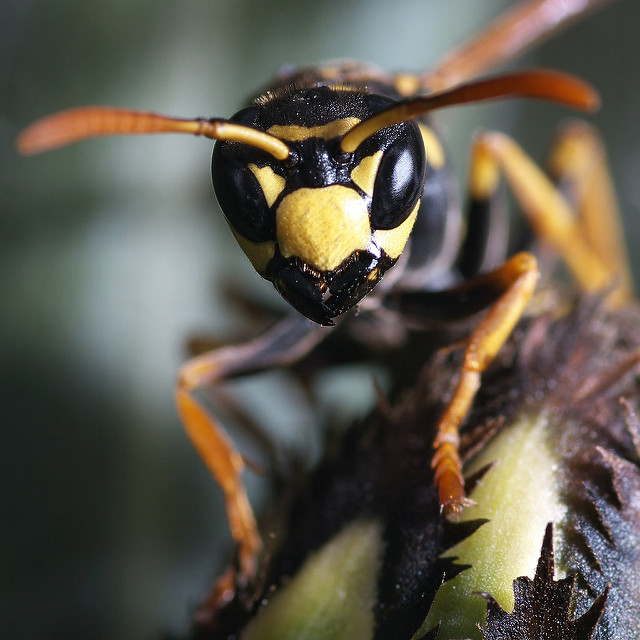Highlighting the article written by R. Branconi, D. Baracchi , S. Turillazzi and R. Cervo (2018) in Insectes Sociaux
Written by Insectes Sociaux Editor-in-Chief, Michael Breed (michael.breed@colorado.edu)

Polistes dominula Photo: Jean-Raphaël Guillaumin/flickr
Social recognition in animals often relies on multiple cues representing disparate sensory modalities. Humans can individually identify others using several types of cue, including voice, appearance, gait, odor, and mannerism. This redundancy makes social recognition particularly robust to changes in surrounding conditions. Even in full darkness human individual recognition is accomplished by voice and odor. The use of overlapping information sets in recognition suggests that identification of others is a key adaptive trait in human social biology.
In eusocial insects, social recognition is equally important and often relies on chemical cues carried on the external surfaces of colony members. A very large body of literature supports the use of chemical cues in social recognition in a wide variety of bees, ants, wasps and termites (Breed 2014). Odors work well in the dark environments of nest interiors and can be blended among workers to yield colony-level identity badges.
The finding, slightly over a decade ago, that a species of paper wasp, Polistes dominula (=dominulus), uses visual signals for social recognition was surprising and, indeed, revolutionary (Tibbets 2006). Other wasps, such as Liostenogaster, are now known to also use variation in facial markings as social signals. The social use of visual signals is probably facilitated by the openness of Polistes nests, allowing vision to function as a cue when wasps are on the nest surface. The variability in cuticular marking patterns is an important component of this system, and significantly, the degree of variability differs among populations of P. dominula.
In this issue Branconi et al (2018) test the function of facial pattern variation in an Italian population of P. dominula. Branconi and colleagues found no evidence for social discrimination based on facial markings. Their extensive experiments were performed in two behavioral contexts, competition during foraging and nest defense. They carefully controlled for odor and movement cues, but did not manipulate potential visual signals by modifying markings on the animals’ faces. In this respect, the experiments differ from those of Tibbets (2006 and a series of more recent studies), leaving a gap that should be filled in future work. The findings of Branconi et al (2018) follow on a similar set of tests in a Spanish population by Green and Fields (2011) which also yielded negative results.
The Italian and Spanish populations have far less phenotypic variation in facial markings than the North American population, an interesting factor in the evolutionary dynamic. A very salient question is whether in the North American population release, from the evolutionary pressures of parasites or predators that are present in the wasp’s native habitat, has relaxed canalization of facial patterns. High levels of signal stereotypy are perfect for species recognition, which is valuable in exclusion of intruders to a nest. On the other hand, highly variable signals are foundational for individual recognition (Breed and Bekoff 1981).
As a general feature, social wasps may have evolved to use visual signals in species identification. Stereotypical, at the species level, cuticular color patterns are prominent in many wasps. Perhaps aposematic signals were co-opted in evolution for recognition purposes. Perhaps it went the other way, with initial selection pressure for interspecific variation in coloration for identification purposes, and then enhancement of these signals through selection for increased aposematic value. Explorations of the evolutionary pathways leading first to cuticular coloration patterns and then to intraspecific variation in pattern will yield fascinating results.
This study should stimulate reflection on the value of negative results, and of the importance of expressing negative results as contributing to a larger view of a problem, rather than invalidating a specific set of previous studies. There is no basis in Branconi et al’s (2018) results and interpretation to question the veracity of the findings from the North American population, and Branconi et al (2018) have in a quite laudable way steered clear of questioning the earlier findings. This study should open the door to truly matched studies between North American and European populations of P. dominula, as well as to deeper considerations of the evolutionary dynamics that have caused wasp populations to differ so dramatically in phenotypic variation of visual signals.
References
Branconi R, Baracchi D, Turillazzi S, Cervo R (2018) Testing the signal value of clypeal black patterning in an Italian population of the paper wasp Polistes dominula. Insectes Sociaux https://doi.org/10.1007/s00040-017-0598-z
Breed MD (2014) Kin and nestmate recognition: the influence of W.D. Hamilton on 50 years of research. Anim Behav 92:271–279
Breed MD, Bekoff M (1981) Individual recognition and social relationships. J Theoret Biol 88:589-593
Green JP, Field J (2011) Interpopulation variation in status signalling in the paper wasp Polistes dominulus. Anim Behav 81(1):205–209. https://doi.org/10.1016/j.anbehav.2010.10.002
Tibbetts EA (2006) Badges of status in workers and gyne Polistes dominulus wasps. Ann Zool Fenn 43:575–582
______________________________________________________________________________________________
Michael Breed, Department of Ecology and Evolutionary Biology, The University of Colorado, Boulder, Boulder CO 80309-0334 USA